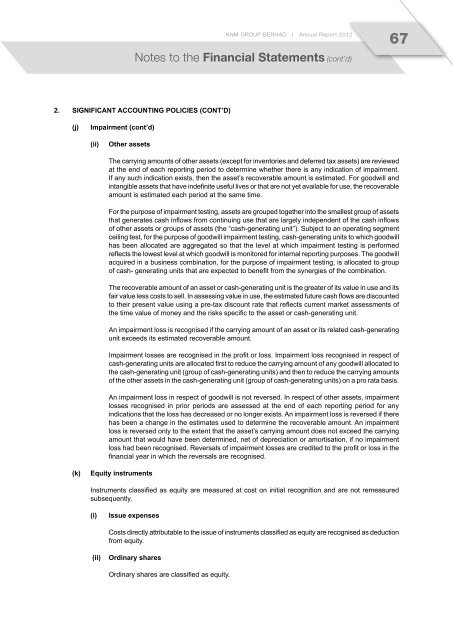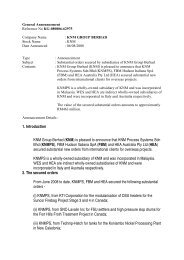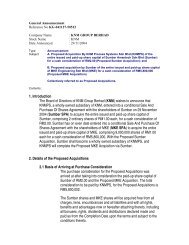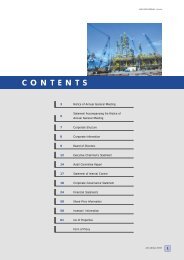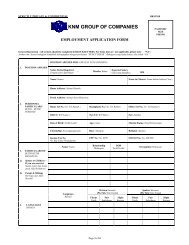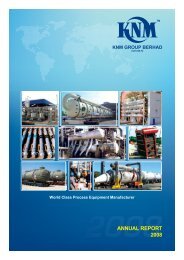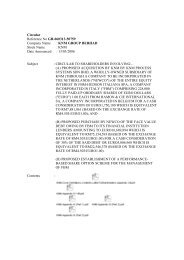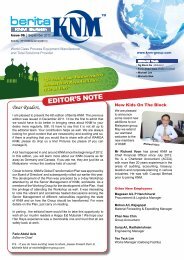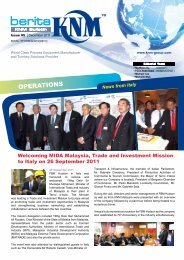cont'd - KNM Steel Sdn Bhd
cont'd - KNM Steel Sdn Bhd
cont'd - KNM Steel Sdn Bhd
- No tags were found...
You also want an ePaper? Increase the reach of your titles
YUMPU automatically turns print PDFs into web optimized ePapers that Google loves.
<strong>KNM</strong> GROUP BERHAD I Annual Report 201267Notes to the Financial Statements (cont’d)2. Significant accounting policies (Cont’d)(j)Impairment (cont’d)(ii)Other assetsThe carrying amounts of other assets (except for inventories and deferred tax assets) are reviewedat the end of each reporting period to determine whether there is any indication of impairment.If any such indication exists, then the asset’s recoverable amount is estimated. For goodwill andintangible assets that have indefinite useful lives or that are not yet available for use, the recoverableamount is estimated each period at the same time.For the purpose of impairment testing, assets are grouped together into the smallest group of assetsthat generates cash inflows from continuing use that are largely independent of the cash inflowsof other assets or groups of assets (the “cash-generating unit”). Subject to an operating segmentceiling test, for the purpose of goodwill impairment testing, cash-generating units to which goodwillhas been allocated are aggregated so that the level at which impairment testing is performedreflects the lowest level at which goodwill is monitored for internal reporting purposes. The goodwillacquired in a business combination, for the purpose of impairment testing, is allocated to groupof cash- generating units that are expected to benefit from the synergies of the combination.The recoverable amount of an asset or cash-generating unit is the greater of its value in use and itsfair value less costs to sell. In assessing value in use, the estimated future cash flows are discountedto their present value using a pre-tax discount rate that reflects current market assessments ofthe time value of money and the risks specific to the asset or cash-generating unit.An impairment loss is recognised if the carrying amount of an asset or its related cash-generatingunit exceeds its estimated recoverable amount.Impairment losses are recognised in the profit or loss. Impairment loss recognised in respect ofcash-generating units are allocated first to reduce the carrying amount of any goodwill allocated tothe cash-generating unit (group of cash-generating units) and then to reduce the carrying amountsof the other assets in the cash-generating unit (group of cash-generating units) on a pro rata basis.An impairment loss in respect of goodwill is not reversed. In respect of other assets, impairmentlosses recognised in prior periods are assessed at the end of each reporting period for anyindications that the loss has decreased or no longer exists. An impairment loss is reversed if therehas been a change in the estimates used to determine the recoverable amount. An impairmentloss is reversed only to the extent that the asset’s carrying amount does not exceed the carryingamount that would have been determined, net of depreciation or amortisation, if no impairmentloss had been recognised. Reversals of impairment losses are credited to the profit or loss in thefinancial year in which the reversals are recognised.(k)Equity instrumentsInstruments classified as equity are measured at cost on initial recognition and are not remeasuredsubsequently.(i)Issue expensesCosts directly attributable to the issue of instruments classified as equity are recognised as deductionfrom equity.(ii)Ordinary sharesOrdinary shares are classified as equity.


